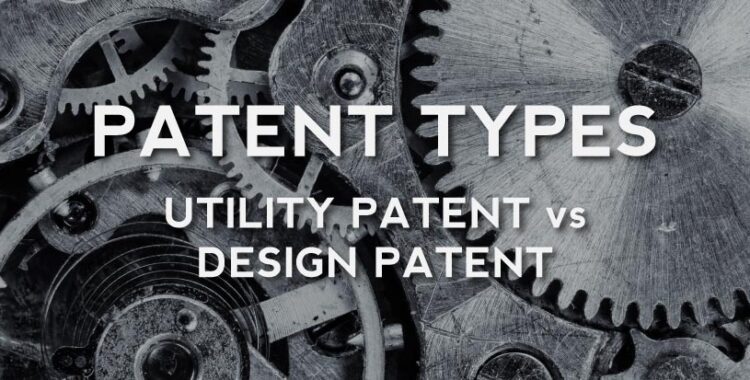Patent Types: Design Patent vs. Utility Patent
If you have created a new invention, a patent allows you to protect your rights to that invention. Patents afford inventors the exclusive right to use, sell, and make their invention for a specific period of time and therefore constitutes a limited monopoly. A patent is awarded by the U.S. Patent and Trademark Office (USPTO); a federal agency that handles the patent application process.
After the government grants you a patent, you can enforce it by taking legal action against anyone who uses, makes, or sells the invention, without your permission, in the United States. Suing another who violates these rights is known as a patent infringement action.
Most people filing for protection will fill for either a design patent or a utility, which constitute most common patents awarded by the U.S. Patent Office. It is essential to determine which type of patent is most suited for your invention as there are specific instances where one is more appropriate than the other.
Utility Patents
If you invent something new that is new and non-obvious, typically you will most often be interested in a utility patent. Utility patents can be generically classified into a few categories including manufactured articles, processes and compositions. Manufactured articles may comprise virtually any created “hard” good and further includes parts of goods as well as machines. Processes may include a plurality of steps to achieve a goal, such as the steps of making a golf ball or the processes utilized in a computer program. Compositions include combinations of constituents, from pharmaceuticals to plastics.
A granted utility patent provides protection for the inventor or owner of the patent rights for 20 years from the date the application is filed.
Pros of Utility Patents
- Preserves the functional, utilitarian aspects of your invention
- Depending on the area of invention (i.e. the art) and the originality of the invention, a utility patent can provide broad protection that extends far beyond the original idea
- Can protect an entire class of products as opposed to one, specific version of an idea
Cons of Utility Patents
- The prosecution of the utility patent application will typically take at least 2-3 years
- Utility patents, due to the large amount of work involved, can be a costly endeavor, though their increased value justifies the added expense
- Protects only the functional aspects of an invention and does not extend to ornamental features
Design Patent
If your invention is not functional but provides a new appearance, you may want to consider filing a design patent to protect those ornamental features. A design patent is not used for protecting mechanical features or processes but can be used for protecting new embodiments of old ideas. For example, if your idea is a new lampshade having a unique shape, you would typically seek a design patent since lampshades are already known and a utility patent would therefore be very difficult to obtain.
While a utility patent protects function, a design patent protects appearance. There can be some blurring of that line and design patents have been awarded for devices that appear, for all practical purposes, to be functional. There is a risk that these types of design patents could be invalidated during litigation. Therefore, the design needs to be ornamental, not functional.
It may seem as though a design patent would have little value since the protection it offers relates to appearance and appearances can be altered easily. However, the ornamental features need not include the entire device, but only a small portion of it. Thus, the shape of an opening in a box may be protected by itself regardless of the shape of the box it is positioned in.
While a utility patent has a term of 20 years from the date of filing, a design patent lasts for 15 years from the date the patent is issued.
Benefits of Design Patents
- The prosecution of a design patent application from filing to issue is relatively quick compared to utility patents and in most cases you can expect it to issue within 18 months
- Design patent applications enjoy a very high allowance rate
- Design patent applications are much simpler to file than a utility patent and this is reflected in their lowered cost
- If the primary feature of the invention is the ornamental design, this patent protects this feature
- Can be used as backup protection in combination with a utility patent when the invention includes ornamental features melded with functional aspects
Detriments of Design Patents
- Design patents do not offer protection for the functional features of inventions, therefore one would not use a design patent to protect components of an engine
- A design patent only covers one version of an invention and while multiple versions may be filed within one application, such applications are almost always divided by the patent examiner into multiple applications leading to additional costs and delays
- Design patents are inherently weaker than a utility patent since a potential copier need only alter some of the ornamental features to avoid infringement
Intellectual Property Playbook
An Entrepreneur's Guide To Patents, Trademarks, and Copyrights GET THE PLAYBOOK
Direct Comparison of Utility and Design Patents
One of the major differences between utility and design patents is the claim scope. Claim scope is the term used to describe what protection the patent is actually affording its owner. In a utility patent, the claims are a set of limitations letting the others know what is protected. For a design patent, the scope of protection is found solely in the drawings. While a design patent and a utility patent might use the same drawings, the utility patent’s protection comes from the words used to describe those drawings. For example, a design of a coffee cup would simply be the exact reproduction of the coffee cup as shown in the drawings. A utility, however, may use terminology such as “a container having a bottom wall, a perimeter wall, and a handle coupled to the perimeter wall.” This example should provide an obvious understanding that the utility patent does not depend on the shape of the cup and therefore offers much broader protection and though a competitor may create a product that looks different, it may still infringe the utility patent. Conversely, a competitor may incorporate the same function and structure but do so using a different appearance to overcome a design patent.
Another difference between utility and design patents is how infringement is determined. A side-by-side comparison is made of the design patent drawings with the accused product for design patent infringement. This comparison is made to determine if the two designs would look substantially similar to an objective observer. The resemblance should be enough to deceive the observer into purchasing one product, supposing it to be the other. For utility patent infringement, one looks to the patent claims to determine if all limitations within the claims are found in the accused product.
When To File A Utility Patent and Design Patent Application
As mentioned above, there are situations where one can obtain both utility and design patent protection for your invention. If the invention has a unique structure and ornamental design, both of these patent protections can be applied for. However, this determination is not always obvious and requires the expertise of a patent attorney. Regardless, both of these applications will provide a “patent pending” status for the inventor while pending at the Patent Office.
The Takeaway
If you have a new invention, it is vital to protect it using a patent. There are different patent protections and undertaking the correct route can save an inventor time and money while providing the maximum protection available. Design patent protection is mainly concerned with appearance and ornamental features, whereas utility patent protection typically deals with the functional aspects of an invention. Consult our team of intellectual property attorneys for advice on which patent application is best suited for your invention.






